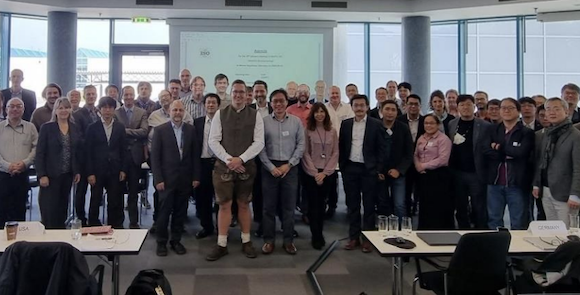ISO/TC 261 AM lays framework for PBF and ceramic standards at Plenary Meeting
November 1, 2022

This year, the International Organisation for Standardisation (ISO) held the 20th Plenary Meeting of ISO/TC 261 Additive Manufacturing in late September in Augsburg, Germany. These meetings take place to standardise Additive Manufacturing as a whole, including the process chains, quality parameters, supply agreements, environment, health & safety, fundamentals and vocabularies.
Preliminary work item ISO/ASTM TS PWI 52949 ‘Additive Manufacturing – Qualification principles – Installation, operation and performance (IQ/OQ/PQ) of PBF-EB equipment’, assigned to ISO/TC 261/JG 72, intends to provide recommended practices for machine-related process qualification for serial production of metal parts produced with the Electron Beam Powder Bed Fusion (PBF-EB/M). Likewise, ISO/ASTM 52930 for Laser Beam Powder Bed Fusion (PBF-EB/M).
Today, there are over two dozen PBF-LB machine manufacturers, each with a unique way of implementing process monitoring sensors as well as visualising, storing, and exporting the data. Preliminary work item ISO/ASTM PWI 52956 ‘Additive Manufacturing for Spaceflight – General principles – Requirements for metal laser beam powder bed fusion additive systems’, assigned to ISO/TC 261/JG 72, will be focused on minimum monitoring capability for PBF-LB machines used for space flight hardware requirements for machine manufacturers to make available to the machine owner and the raw data created by the sensors.
The preliminary work item ISO/ASTM PWI 52957 ‘Additive Manufacturing – Design – Parts using ceramic materials’, assigned to ISO/TC 261/JG 82 provides support to technology users, such as designers and production engineers, when designing parts that need to be manufactured by means of ceramic Additive Manufacturing. It is intended to help practitioners explore the benefits of this technology and to recognise the process-related limitations when designing parts. It also builds on ISO/ASTM 52910 to extend the requirements, guidelines, and recommendations for AM design to include the ceramic process.
Acknowledging the interest of the members of ISO/TC 261/WG 6 of aspects related to the Life Cycle Assessment of Additive Manufacturing products, equipment, operations, product usage and end-of-life, the Technical Committee has decided to establish a liaison with ISO/TC 207/SC 5 ‘Life Cycle Assessment’ to ensure a fruitful exchange of information, to efficiently coordinate the work between ISO/TC 261 and ISO/TC 207/SC 5, to avoid overlaps in the work.
Before the Plenary itself, the ASTM COE Workshop on Advanced Industrial Applications – Driving Additive Manufacturing Forward was held. This consisted of around thirty technical joint group meetings and after-hours visits to Fraunhofer IGCV, the Augsburg Chamber of Commerce and EOS GmbH.
















